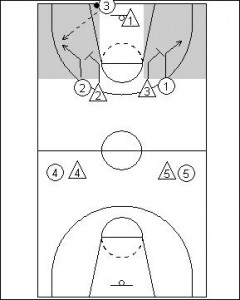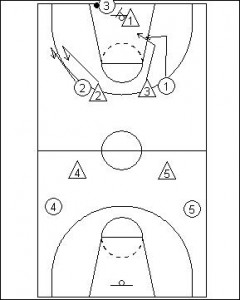Defensive Variations for Guarding the Inbound Pass; a 1-2-2 Full Court Press Example
The 1-2-2 Full Court Press is one of the staples many coaches end up utilising as they develop their understanding about pressure defences. The 1-2-2 Full Court Press is one of the more popular defences to be used in basketball. For this reason there is no shortage of information available across the internet in regards to the strategy behind the defence.
The 1-2-2 Full Court Press places a number for players in a condensed space. This challenging for younger players especially who cannot make longer passes down the court and over the defence. As with all press options teams need to be well drilled in rotations and recovering behind the line of the ball.
The 1-2-2 Full Court Press is a solid defence with a proven track record of success. When teaching this defence it helps build confidence and allow for a greater margin of error as players work in lines which tend to be simplistic to explain the options and rotations they have.
To try and add a different perspective on the discussion about the 1-2-2 Full Court Press below are some variations in regards to how to defend the initial inbound pass. The inbound pass below has been diagrammed to be defended in two different ways. The two different strategies discussed here will be passive and denial of the inbound pass. Both of these have different purposes strategically for a team to utilise.
Passive defending in the 1-2-2 Full Court Press allows the ball to be inbounded before the trap is initiated. This type of defence can be utilised in allowing the inbound pass to happen in the confined corners of the backcourt. This is a useful strategy if the team you are defending has only limited dribblers or passers who will struggle to dribble out or pass through a full court pressure defence.

Additionally the passive defence option can be utilised as a strategy to delay the game and dry up valuable time an opposition team may need to score and close a points gap. You do not necessarily have to trap for this defence to be effective in this way. Most offensive teams will tend to take longer to progress the ball when facing a press. Even fewer are effective in the full court resulting in scoring opportunities out of transition against a press defence.
The other option highlighted here is the full Denial of the inbound pass. This option within the 1-2-2 Full Court Press sees the three defenders initially involved in the trap deny their defensive assignments from receiving the inbound pass. This can either be done by the two defenders in the second line of the defence aggressively marking the offensive outlet or this can be supplemented by the point defender also face guarding the outlets and denying the pass to the first player who become free.

Denying the pass is a great tactic against a team that has one particularly strong guard who you do not want to have the ball in their hands. This defence is also very effective in having your team change-up their defence in the closing minutes of a quarter. If not used during a game in the general play, then when this defence is implemented it can be very disruptive.
Passive and denial variations are nothing different to basketball defences. These simple deviations in tactical focus can be very effective when integrated into many defences. Just because the focus of this article has been on full court defence, don’t think that these elements could not also be utilised in the half court for instance when teams are inbounding the ball.
Utilising these options for your team’s defensive tactics will allow your player’s to adapt and continue to apply pressure to offensive players as individuals and as teams. What is also useful is changing the rotation of implementation of these tactics on the court. Having your team utilise full denial of the pass and then passive defence strategies will help break the rhythm of your opposition and confuse their players with regards to what tactics to employ.





